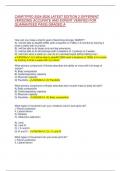CANFITPRO 2024-2026 LATEST EDITION 2 DIFFERENT
VERSIONS| ACCURATE AND EXPERT VERIFIED FOR
GUARANTEED PASS| GRADED A
How can you make a client's goal of becoming stronger SMART?
A) I will be able to deadlift 225lb (with a baseline of 135lb) in 6 months by training 4
times a week with my trainer.
B) I will be able to do bicep curls and leg extensions
C) I will be able to do 50 pushups (with a baseline of 1 pushup) in 2 weeks.
D) I will train twice a week so I can do an overhead squat without falling over. -
✔✔ANSW✔✔..A) I will be able to deadlift 225lb (with a baseline of 135lb) in 6 months
by training 4 times a week with my trainer.
What primary component of fitness describes the ability to move with full range of
motion?
A) Body composition
B) Cardiorespiratory capacity
C) Muscular capacity
D) Flexibility - ✔✔ANSW✔✔..D) Flexibility
What primary component of fitness describes lean muscle mass to body fat ratio?
A) Body composition
B) Cardiorespiratory capacity
C) Muscular capacity
D) Flexibility - ✔✔ANSW✔✔..A) Body composition
What types of movement can your vertebral column and spine do?
I. Flexion-extension
II. Lateral flexion
III. Rotation
IV. Abduction-adduction
A) I only
B) I and IV
C) I, II, and III
D) III and IV - ✔✔ANSW✔✔..C) I, II, and III
What types of movement can your knee joint do?
I. Flexion-extension
II. Lateral flexion
,III. Rotation
IV. Abduction-adduction
A) I only
B) I and III
C) I, II, and III
D) II and IV - ✔✔ANSW✔✔..B) I and III
What types of movement can your hips do?
I. Flexion-extension
II. Circumduction
III. Rotation
IV. Abduction-adduction
A) I only
B) I and IV
C) I, II, and III
D) all of the above - ✔✔ANSW✔✔..D) all of the above
What types of movement can your shoulder girdle (scapula, clavicle) do?
I. Flexion-extension
II. Circumduction
III. Rotation
IV. Abduction-adduction
A) I only
B) II and IV
C) I, III, and IV
D) all of the above - ✔✔ANSW✔✔..C) I, III, and IV
(can also do elevation-depression)
What types of movements can your ankle joints do?
I. Medial and lateral rotation
II. Plantar flexion-dorsiflexion
III. Abduction, adduction
IV. Eversion, inversion
A) I only
B) II and IV
C) III and IV
D) I, III, and IV - ✔✔ANSW✔✔..B) II and IV
What are the vertebrae of the spine called? - ✔✔ANSW✔✔..Cervical, thoraric, lumbar,
sacral, coccyx.
, EPOC is used for all of the following processes except:
A) ATP replenishment
B) CP replenishment
C) digestion of carbohydrates to glucose
D) conversion of lactate to glucose - ✔✔ANSW✔✔..C) digestion of carbohydrates to
glucose
What muscles are a part of the SITS rotator cuff? - ✔✔ANSW✔✔..Supra &
infraspinatus, teres minor, subscapularis
What are some factors related to strength? - ✔✔ANSW✔✔..Muscle size, muscle length,
speed of contraction, neural control
What is the antagonist muscle to the quadriceps? - ✔✔ANSW✔✔..Hamstrings
For an elbow flexion, the antagonist is the ______ and the agonist is the _____. -
✔✔ANSW✔✔..Triceps brachii; biceps brachii
The erector spinae is the antagonist to... - ✔✔ANSW✔✔..Rectus abdominus
The anterior tibilias is the antagonist to... - ✔✔ANSW✔✔..Gastrocnemius and soleus
What are SMART goals?
A) Specific, measurable, attainable/action, realistic, time sensitive
B) - ✔✔ANSW✔✔..Specific e.g, I want to be more fit —> what does that mean?
Measurable; objective units. e.g, I want to be more fit —> how much weight do you want
to lose?
Attainable; frequency. e.g., do you have the time and resources to do it?
Realistic e.g., losing 50 pounds in one month is not realistic
Time Sensitive e.g., having a 'due date' (e.g., by Jan. 1, 2019)
What are the primary components of fitness?
A) Cardiorespiratory capacity, muscular capacity, flexibility, body composition
B) Body fat percentage, lean muscle mass, nutritional intake, intensity of workouts
C) Frequency, intensity, time, type
D) Heart rate, blood pressure, strength, flexibility - ✔✔ANSW✔✔..A) Cardiorespiratory
capacity, muscular capacity, flexibility, body composition
What are the six fundamental movements? - ✔✔ANSW✔✔..1. Push
2. Pull
3. Bend
4. Rotation
5. Squat
6. Lunge




